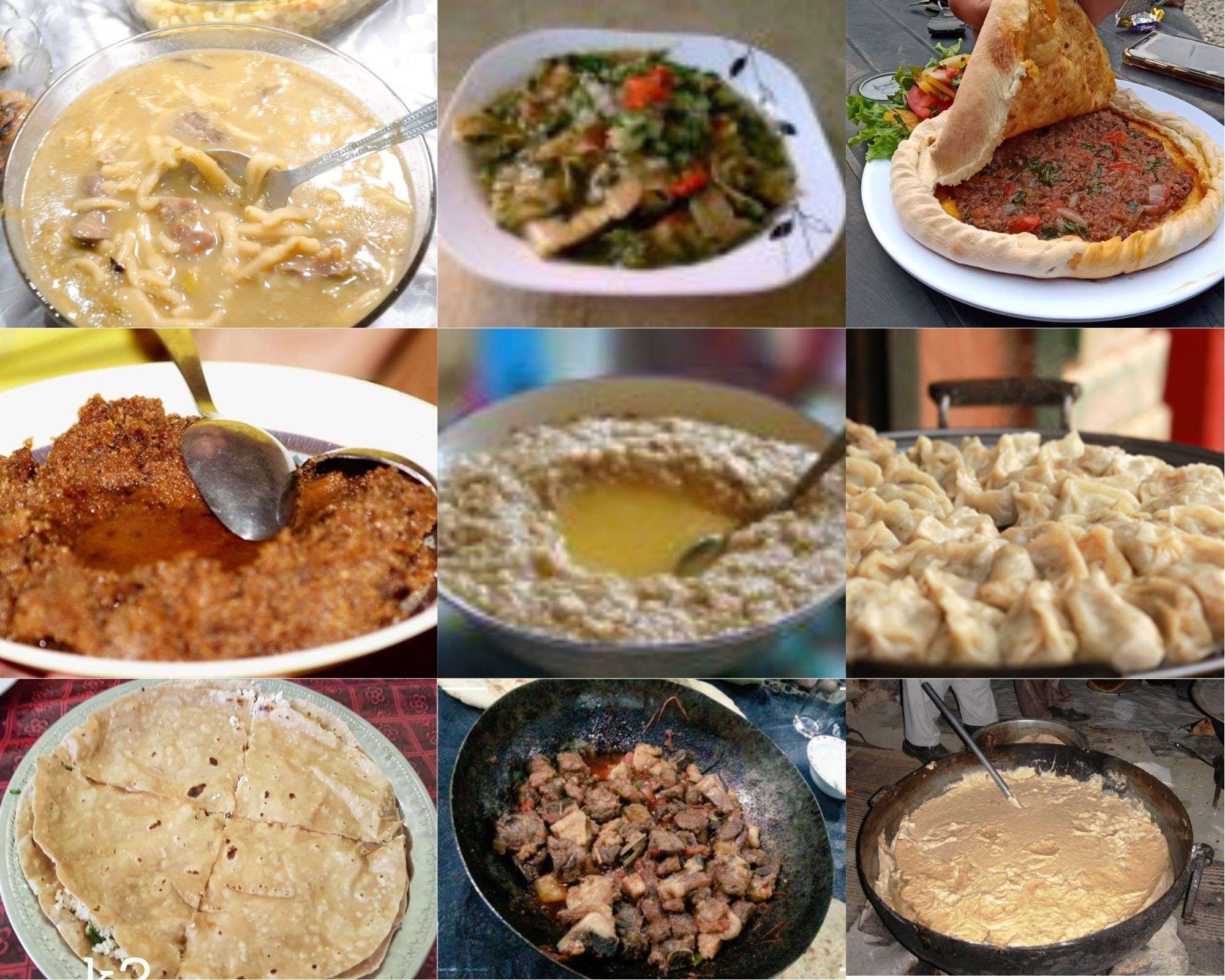Are you looking for the most famous food of Gilgit Baltistan? As we explore the enthralling world of Gilgit-Baltistan’s culinary treasures, embark on a delectable journey of taste and culture. In “Exploring the Delectable Delights of Gilgit-Baltistan: A Culinary Journey through Famous Foods,” we reveal the mysteries of the culinary delights of this alpine region. Gilgit-Baltistan, which lies tucked between the Himalayas and the Karakoram Range, is home to breathtaking vistas as well as a rich culinary tradition that reflects its varied history and arid geography.
The Gastronomic Tapestry:
Gilgit-Baltistan’s cuisine is a delightful blend of Central Asian, Tibetan, and South Asian flavors, resulting in a unique tapestry of tastes and aromas. The region’s remote location has influenced its culinary practices, giving rise to dishes that are hearty, flavorful, and suited to the demanding terrain.

1. Chapshuro: A Meat Lover’s Delight
Tucked away in the heart of Gilgit-Baltistan’s culinary heritage, the dish “Chapshuro” has captured the palates and hearts of locals and tourists alike. With a symphony of flavors, textures, and scents that reflect the region’s varied cultural influences, this robust delicacy is a real treat for meat lovers.
Ingredients:
Chapshuro’s magic lies in its simplicity and careful combination of ingredients. The dish primarily centers around minced meat, often mutton, which forms the savory core. Mix finely chopped onions, an assortment of aromatic spices, and occasionally fresh herbs like cilantro or mint with the meat. Thoughtfully encase this blend in a thin layer of dough, adding a satisfying contrast to the succulent filling.
Preparation:
The preparation of Chapshuro requires precision and patience. The minced meat is sautéed with the onions until they caramelize and release their sweet aroma. Adding a medley of cumin, coriander, red chili, and turmeric infuses the mixture with a robust and enticing flavor. Once the meat filling cooks well and absorbs spices, it slightly cools before expertly enveloping it in the dough.
Typically, people roll out the dough into thin rounds resembling pastries or flatbreads. Then, they gently fold one side of the dough over to create a semi-circular pocket, delicately placing the chilled meat mixture on it. To ensure complete enclosure of the filling, they precisely crimp or press together the edges of the dough.
Cooking Methods:
Traditionally, Chapshuro is cooked using two popular methods: baking or pan-frying. When baking, a preheated oven is used to cook the stuffed dough pockets until they achieve a golden-brown hue, allowing the flavors to meld and intensify. On the other hand, pan-frying involves lightly greasing a pan and cooking the Chapshuro until it becomes crispy and irresistible, with the aroma of the spices wafting through the air.
Serving and Accompaniments:
Chapshuro is often served as a standalone dish or accompanied by various sides. It can be paired with fresh vegetable side salads or a tangy yogurt-based dip, which cuts through the richness of the meat and spices. You can also eat this adaptable dish by itself, letting the flavors of the meat and the spices take center stage.
Cultural Significance:
Beyond its delectable taste, Chapshuro holds cultural significance in Gilgit-Baltistan. It is frequently shared during gatherings, celebrations, and festivals, symbolizing togetherness and warmth. The preparation and sharing of Chapshuro highlight the close-knit nature of the communities in the region, where food is not just sustenance but also a means of bonding and connection.
2. Harissa: A Warming Porridge

People in Gilgit-Baltistan hold a special place in their hearts for harissa, a traditional cuisine with Central Asian origins. Spending hours slowly simmering a mixture of wheat, meat (often chicken or mutton), and spices create this filling porridge, resulting in a warming, wholesome dish well-liked throughout the long winters.
Ingredients and Preparation:
The art of creating Harissa is a labor of love that requires patience and dedication. The dish is traditionally prepared using wheat, meat (usually chicken or mutton), and a carefully selected array of spices. The process begins by washing the wheat thoroughly and then soaking it for several hours or even overnight. This ensures that the grains soften, facilitating the cooking process. The soaked wheat is then drained and combined with the meat in a large pot.
Harissa’s slow cooking is what gives it its true magic. For several hours, often even overnight, the mixture of meat and wheat is simmered gradually. The wheat grains disintegrate and meld with the meat throughout the lengthy cooking period, giving the food a thick, creamy consistency. The mixture is frequently stirred to prevent it from sticking to the bottom of the saucepan.
Aromas and Flavors:
As Harissa simmers away, its inviting aroma permeates the air, drawing people together in anticipation of a comforting meal. The addition of spices such as cloves, cardamom, and cinnamon infuses the porridge with a rich and warming fragrance that speaks to the senses. The meat imparts its essence into the mixture, enhancing the overall depth of flavor.
Culinary Unity:
Families and neighbors frequently come together to participate in the cooking process for Harissa. Families and neighbors often unite to engage in the cooking process for Harissa. This practice not only shares the workload but also bolsters the sense of belonging and community integral to Gilgit-Baltistan culture. Given its substantial quantity, the dish is perfect for sharing at gatherings, festivals, and special occasions.
This technique not only distributes the burden but also bolsters the sense of belonging and community ingrained in Gilgit-Baltistan culture. Due to its large portions, the meal is perfect for sharing at gatherings, festivals, and special events.
Harissa and Cultural Significance:
Beyond its culinary allure, Harissa holds cultural significance in the region. Traditionally served during the winter months, this hearty porridge provides essential nourishment and warmth during the unforgiving cold. It’s a dish that has been passed down through generations, carrying with it the stories and traditions of Gilgit-Baltistan’s people.
3. Shab Deg: The Celebratory Stew
“Shab Deg” is a communal feast, a testament to Gilgit-Baltistan’s culinary heritage, cooked during festive events and gatherings this flavorful stew, slow-cook a variety of ingredients—meat, veggies, lentils, and spices—overnight in a big pot. Extended cooking melds flavors, creating a mouthwatering dish symbolizing harmony and community bonding.
Ingredients and Preparation:
Shab Deg is not merely a dish; it’s an experience that requires meticulous preparation and patience. The dish typically involves a harmonious blend of ingredients that includes tender meat, aromatic spices, wholesome vegetables, and fragrant herbs. Shab Deg’s essence is slow-cooking: meats, lentils, and vegetables simmer overnight, creating a rich, flavorful dish. Slow cooking blends flavors for a deeply satisfying and comforting taste profile, enriched by prolonged cooking.
Cultural Significance:
Beyond just being delicious, Shab Deg is incredibly important to Gilgit-Baltistan’s culture. Families, groups, and communities frequently make and enjoy this stew together during festivals, gatherings, and special occasions. Slow-cooking food for an extended period not only intensifies the flavors but also shows the effort and care the cooks put into it, signifying the significance of time and tradition.
Unity and Togetherness:
Shab Deg is more than a dish; it’s a symbol of unity and togetherness. The act of cooking and sharing this stew brings people closer, fostering a sense of belonging and camaraderie. The dish’s communal aspect reflects in the traditional serving method – from a single large pot. As friends and family gather around, they share stories, laughter, and the joy of breaking bread together. Shab Deg embodies the age-old tradition of breaking barriers and building bridges through the simple act of sharing a meal.
Flavors and Aromas:
A simmering pot of Shab Deg emits enticing fragrances that fill the air with a mouthwatering combination of spices and delicious goodness. The stew has a substantial, deep taste profile that perfectly balances the earthiness of the lentils, the sweetness of the veggies, and the tenderness of the beef.
4. Momos: From Tibet to Gilgit-Baltistan
The influence of neighboring Tibet is evident in Gilgit-Baltistan’s love affair with “Momos.”
Filled with various ingredients like minced meat, vegetables, or cheese, these dumplings frequently accompany a tangy dipping sauce. Momos have become a popular street food, capturing the essence of the region’s multicultural culinary heritage.
Origin and Cultural Exchange:
Momos, the delectable dumplings that have gained immense popularity in Gilgit-Baltistan, trace their origins back to Tibet. These savory delights are a testament to the cultural exchange that has taken place over centuries along the ancient trade routes connecting Tibet, Central Asia, and South Asia. As trade and migration occurred, so did the exchange of culinary traditions, and momos found their way into the heart of Gilgit-Baltistan’s cuisine.
Preparation and Varieties:
Momos are a deft blending of flavor and simplicity. Making dough out of wheat flour, water, and occasionally salt is the preparation process. Delicate, circular wrappers made from this dough encase the delicious ingredients. The fillings themselves come in a wide variety to suit a variety of tastesA traditional option includes mixing minced meat, often mutton, with onions, garlic, and an array of spices. Vegetable, cheese, or paneer fillings are equally alluring for those who choose vegetarian options.
Crafting and Folding:
The process of crafting momos is as much a culinary skill as it is an art. After carefully filling the thin dough wrappers with the chosen mixture, one proceeds with the intricate folding process. Delicately pleating and twisting the wrappers creates sealed pockets that hold the flavorful contents within. The expertise lies in achieving the perfect balance between texture and taste – a thin, soft wrapper that encases a burst of flavors with every bite.
Steaming and Serving:
The process of steaming momos comes next. They place the prepared momos in a steamer, steaming them until the ingredients are perfectly cooked and the wrappers turn transparent. In addition to cooking the dumplings, the steam also preserves the natural flavors of the ingredients. When momos are prepared, they are frequently accompanied by a side of tangy dipping sauce, which is frequently a concoction of red chilies, tomatoes, garlic, and spices. A pleasure for the senses is the interaction of the delicate flavor of the momos and the vivid sauce.
Cultural Significance:
Momos have transcended their culinary roots to become a symbol of cultural connection and community. In Gilgit-Baltistan, they symbolize the harmony between diverse cultures and the exchange of flavors that have shaped the region’s identity. Whether shared in homes, enjoyed at street stalls, or served at festive gatherings, momos bring people together, fostering a sense of camaraderie and shared heritage.

5. Phakkebaazi: The Yogurt Delight
The meal known as “Phakkebaazi,” which is simple yet delicious, is at the center of Gilgit-Baltistan’s gastronomic offerings. Due to the importance of dairy production in the area, yogurt, an ingredient that plays a big role in the region’s culinary traditions, is the focal point of this traditional dish.
For ages, people have cherished Phakkebaazi, savoring a straightforward yet savory experience that captures the essence of regional culture.
Ingredients and Preparation:
The preparation of Phakkebaazi is refreshingly uncomplicated, showcasing the raw and natural flavors of the ingredients. Thick yogurt forms the foundation of this dish, often sourced from the region’s cattle or yaks. Preparing Phakkebaazi is refreshingly uncomplicated, revealing the raw and natural flavors of the ingredients. This dish’s foundation is thick yogurt, often sourced from the region’s cattle or yaks. Typically, straining the yogurt achieves a creamy consistency, ensuring a rich and velvety texture. The yogurt is typically strained to achieve a creamy consistency, ensuring a rich and velvety texture.
To elevate the flavor profile, a blend of local spices is added to the yogurt. This mixture may include ingredients such as cumin, red chili flakes, and a touch of salt. The spices not only enhance the taste but also bring a harmonious balance to the overall composition.
Carefully selected spices complement the tanginess of the yogurt, creating a symphony of flavors that dance on the palate.
Serving and Enjoyment:
In Gilgit-Baltistan’s cuisine, various main courses are typically accompanied by Phakkebaazi, served as a side dish. Its refreshing nature makes it an ideal counterpart to hearty meat dishes and robust stews.
Yogurt’s tanginess readies the palate for the region’s diverse flavors, enhancing the culinary experience.
Phakkebaazi is more than just a side dish; it has cultural significance in the area. Frequently shared with friends and family, it fosters a sense of community and togetherness.
Sharing meals and enjoying Phakkebaazi reflects Gilgit-Baltistan’s friendly hospitality and deep-rooted traditions.
A Symbol of Simplicity:
What makes Phakkebaazi truly stand out is its celebration of simplicity. In an age of complex culinary techniques and fusion creations, this yogurt delight remains true to its roots, embracing the basic elements that define its essence.A dish embodying Gilgit-Baltistan’s pastoral lifestyle cherishes and preserves the connection between nature, culture, and food.
Read About: Gilgit-Baltistan Famous Places 2023



